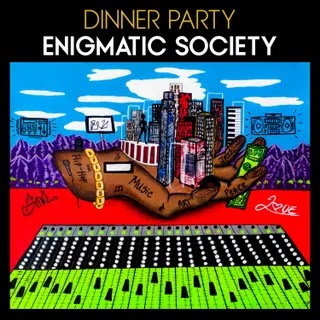Esperanza Spalding’s eighth album is a strangely romantic, sometimes didactic effort to mold the often private experience of listening and feeling the healing power of music.
It’s been 15 years since Esperanza Spalding’s auspicious debut Junjo. After that largely jazz-rooted recording, the multi-instrumentalist singer/songwriter collaborated with Janelle Monáe, Bruno Mars, and Harry Belafonte while composing and releasing six more albums. Spalding’s projects have reflected her compulsive need to expand the range of her artistry beyond jazz, and each collaboration reveals an artist invested in both the heart and craft of music. The bones of her releases still lean on improvisation and sparkling tones. Yet the sinew of her art-making has evolved—a shift audible on her eighth album Songwrights Apothecary Lab, which showcases a musician reluctant to embody any single mode of expression. Spalding has honed in on a lyricism that is psychologically tougher, less concerned with pleasure, and more aligned with revealing tiers of hurt and how they cling to our bodies.
Spalding recorded the album over several months this year and created a guide that describes the intended uses and effects of its 12 compositions, sequentially numbered Formwela 1, 2, 3, etc. The assigned healing properties of each song came from Spalding’s conversations with music therapists and neuroscientists whom she intentionally sought out for a record meant to have a specific healing effect on the listener. SAL is a strangely romantic, sometimes didactic effort to mold the often private experience of listening and feeling music. Taking a note from Alice Coltrane’s own healing melodies on her albums Divine Songs and Infinite Chants, Spalding offers the type of medicine that comes from days moving through nature or intentional solitude. The recipes here are as ancient as they are intuitive.
It’s remarkably unconventional and, at times, stifling listening to an album that comes with a how-to manual, though the concept isn’t unfamiliar. Music has long been a tool for healing, whether as therapy for patients or to commune with gods and ancestors. Spalding has turned those rituals into direct action for listeners seeking solace in her voice. Opener “Formwela 1” is a slow build of layered harmonies that slip into her crystal clear vocals, sitting atop a strumming guitar and gentle piano. The guide labels this song as one for “an acute moment of stress in the home,” and it’s that specificity of place that sets Spalding’s intention from the beginning. Her meeting with multi-instrumentalist Ganavya Doraiswamy on “Formwela 2” is ethereal and deeply rooted in the traditions that shaped it: the movement and philosophy of Harikathā; the poetry and elasticity of jazz.
The album’s three back-to-back collaborations with trombonist Corey King are dynamic and intrepid in balancing both artists’ skills. “You know we all see and make-believe, please, yes/What do you need, babe?” Spalding sings on “Formwela 4” before proceeding into a tender call and response with King, both singing, “Dare to say it,” as they urge us to love ourselves enough to dream our peace into existence. There are elements of Sade’s “King of Sorrow” in the acknowledgment of pain, but where the latter sinks further into despair, Spalding’s acceptance of that feeling is a reawakening. On “Formwela 5,” the duo perform pirouettes around each other’s vocals, spinning and spinning without stuttering or losing sight of the rhythm. “Promise while I’m working at it/I love you, I love you, I love you, I love you,” they offer as an urgent chant. On “Formwela 6,” Spalding leads while King is a ready and capable partner, adding the right amount of heart to a track that’s restrained and almost unsettling in its rhythmic simplicity.
Where the album falters is when formwelas lose the sense of space and intimacy crafted at the beginning. “Formwela 8,” a nearly 12-minute track, trudges at the same pace and never finds footing, its harmonizing bookended by drums and saxophone. After a few bars, the repetition starts to lag, weighing down the gentle piano notes. According to the guide, it’s a “formwelation” meant to foster the “buoyancy of a secure, comfy, and same home-place.” But the track has none of this lightness and assurance. “Formwela 9” plays off the confusion stirred up in the preceding track, and while Spalding’s improvisation takes center stage, the song feels unfinished and cold compared to the album’s first half. Spalding returns to form on closer “Formwela 13,” whose lyrics confidently hang over the horn and impatient percussion. It’s playful and unpretentious, making room for both silence and activity in relationships: “Love the way I do that thing we do/Smile with me, ’cause you do it, too.”
I found myself wondering if “formwela” is the combination of “form” and “well”—whether they function as sounds to help us form well the ties that bind us. While unmoored in parts, SAL compels listeners to find meaning in places they never looked; and in their most well-formed states, the songs lightly probe without being intrusive. Spalding is determined to reach you, even if she can’t touch you.
















0 comments:
Post a Comment